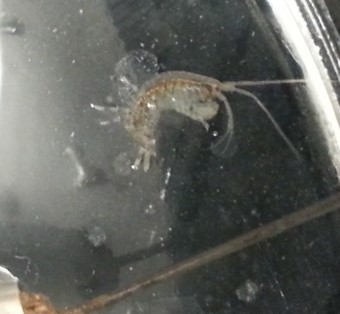At times, it seems like amphipods are everywhere. Whether you’re walking down a sandy shore, diving to the deepest depths of the world’s oceans, or just sitting in the lab studying arborescent bryozoans through a scope, members of the crustacean Order Amphipoda make their appearances. The amphipods with which most people are probably the most familiar are the shrimp-like members of the Suborders Gammaridea and Senticaudata (Horton et al. 2013). Like most other amphipods, gammarideans are laterally-flattened and typically small, usually less than a (Encyclopedia Britannica Online 2014). Many a person enjoying a day at the beach has noticed the prevalent gammarideans commonly known as “sandhoppers” bouncing around like fleas. Here in our invertebrate biology lab, I have found that small gammarids (gammarideans of the Family Gammaridae) also have a tendency to make random cameos whenever you are trying to view entirely different organisms.
Though these ubiquitous small gammarids have important ecological roles, especially as a prey source for a range of organisms from insects to shorebirds to cnidarians, they do lack a certain magnificence. When I first started learning about invertebrate biology, the incidental discovery of a small amphipod in the lab or in the field was actually a little bit exciting. Unfortunately, as the random appearances of small gammarids have become redundant, the feeling of mild delight they used to bring seems to have faded somewhat.
The thing is, there’s a whole lot more to the amphipods than just the gamarrids, even if those are the ones that seem to be most commonplace. For instance, the Order Amphipoda also includes the skeleton shrimp, which are in the family Caprellidae and which a strikingly different form and behavior from the gammarids (see photo). With their long, thin, “bony” bodies (hence the name), the skeleton shrimp attach to the underwater substrate and sway with the current, sweeping with its antennae to catch bits of food drifting by. While their feeding lifestyle is mainly detrivorous, some skeleton shrimp – such as the invasive species Caprella mutica – have actually been shown to use this feeding behavior for capturing prey (Boos et al. 2011). Although they proved somewhat elusive in our lab at UC Davis, we had a great opportunity to witness and record this feeding behavior when we visited the Monterey Bay Aquarium, where they are featured (see video). I think the contrast between the gammarids and the bizarre-looking appearance and mode of feeding of the skeleton shrimp showcases the diversity of the amphipods rather well.

A skeleton shrimp (caprellid amphipod) found at Lincoln Park in Western Seattle. Image credit: (C) Dan Hershman, via Flickr (www.flickr.com)
video showing caprellid amphipods at the Monterey Bay Aquarium (Video Credit: Jeffrey Haight)
Even among the gammarideans and their shrimp-like relatives, amphipods are certainly not lacking in intrigue. When I think of amphipods, my thoughts first go to a short news article I first came across about two years ago about how a marine scientists studying deep-sea trenches off the coast of New Zealand discovered gammarid amphipods of an unprecedented size (Mosher 2012). While deep-sea amphipods have been known to exist for upwards of a hundred years, they typically are only about 1 inch long. One particular amphipod specimen collected by these researchers – from a depth of 4.35 miles – was 29 whole centimeters long, dwarfing the previous largest known individual that was less than 10.6 cm (Jamieson et al. 2013). Compared to the tiny amphipods living in shallower waters and on land, the sheer size of these ‘supergiant’ deep-sea amphipods is quite impressive. Amphipods may be seen as commonplace, but with the discovery of such massive creatures in the depths of our oceans, who knows what else there might be for us to learn about this order that we thought we knew so well.
References
Boos, K.; G.V. Ashton; and E.J. Cook (2011). The Japanese Skeleton Shrimp Caprella mutica (Crustacea, Amphipoda): A Global Invader of Coastal Waters. In the Wrong Place – Alien Marine Crustaceans: Distribution, Biology and Impacts 6, pp. 129-156.
Encyclopedia Britannica Online (2014). “amphipod.” Retrieved 5 March 2014. <http://www.britannica.com/EBchecked/topic/21587/amphipod>.
Horton, T.: J. Lowry; and C. De Broyer (2013). World Amphipoda Database. Retrieved 5 March 2014. < http://www.marinespecies.org/amphipoda on 2014-03-19>.
Jamieson, A.J.; N.C. Lacey; A.-N. Loerz; A.A. Rowden; and S.B. Piertney (2013). The supergiant amphipod Alicella gigantea (Crustacea: Alicellidae) from hadal depths in the Kermadec Trench, SW Pacific Ocean. Deep Sea Research Part II: Topical Studies in Oceanography 92 (SI), pp. 107-113.
Mosher, D. (2012). Pictures: “Supergiant,” Shrimp-Like Beasts Found in Deep Sea. National Geographic. Retrieved 3 March 2014. <http://news.nationalgeographic.com/news/2012/02/pictures/120206-supergiant-amphipods-science-shrimp-crustaceans/>.
